Abstract
Noninfected erythrocytes form rosettes around those infected with trophozoites and schizonts of Plasmodium falciparum in vitro. These rosettes are thought to contribute to the microvascular obstruction which underlies the pathophysiology of severe falciparum malaria. To determine whether the percentage of infected erythrocytes forming rosettes for a parasite isolates in vitro correlates with the in vivo severity of disease, we studied the rosette formation behavior of 35 isolates of P. falciparum from patients with uncomplicated, severe, and cerebral malaria. There was a wide variation in the degree of rosette formation (0 to 53%). Four parasite isolates formed rosettes well (30 to 53%), and seven isolates formed rosettes poorly or not at all (0 to 5%), while the majority of the isolates formed rosettes to various degrees between these two extremes. In this relatively small sample of patients, we were unable to demonstrate a significant association between in vitro rosette formation and patients with cerebral malaria or conscious patients with significant renal (serum creatinine greater than 200 mumol/liter) or hepatic dysfunction (serum bilirubin greater than 50 mumol/liter and aspartate aminotransferase greater than 50 Reitman-Frankel units). However, there was an inverse relationship between rosette formation and cytoadherence (r = -0.575, P less than 0.01) which could not be explained on the basis of steric hindrance. This finding suggests that cytoadherence and rosette formation properties are intrinsic to the parasites, with isolates having a greater propensity for one or the other but not both. Further studies are required to establish the occurrence and pathophysiological role of rosette formation in vivo.
Full text
PDF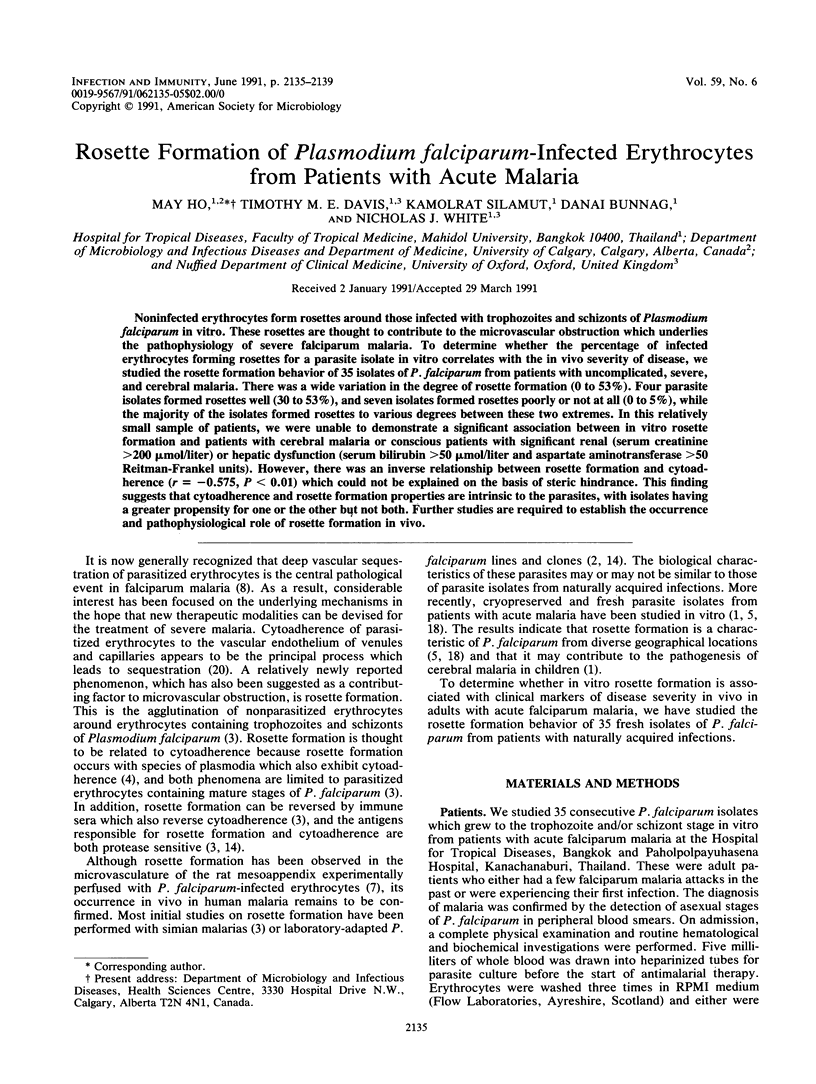
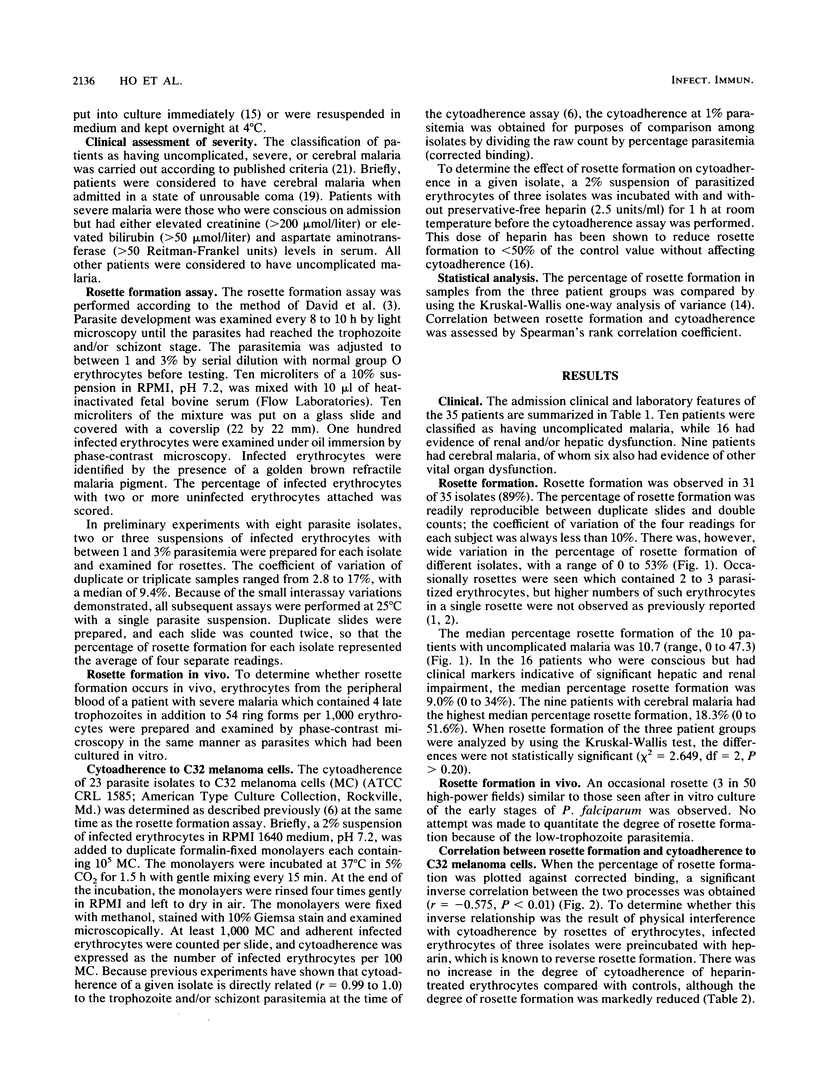
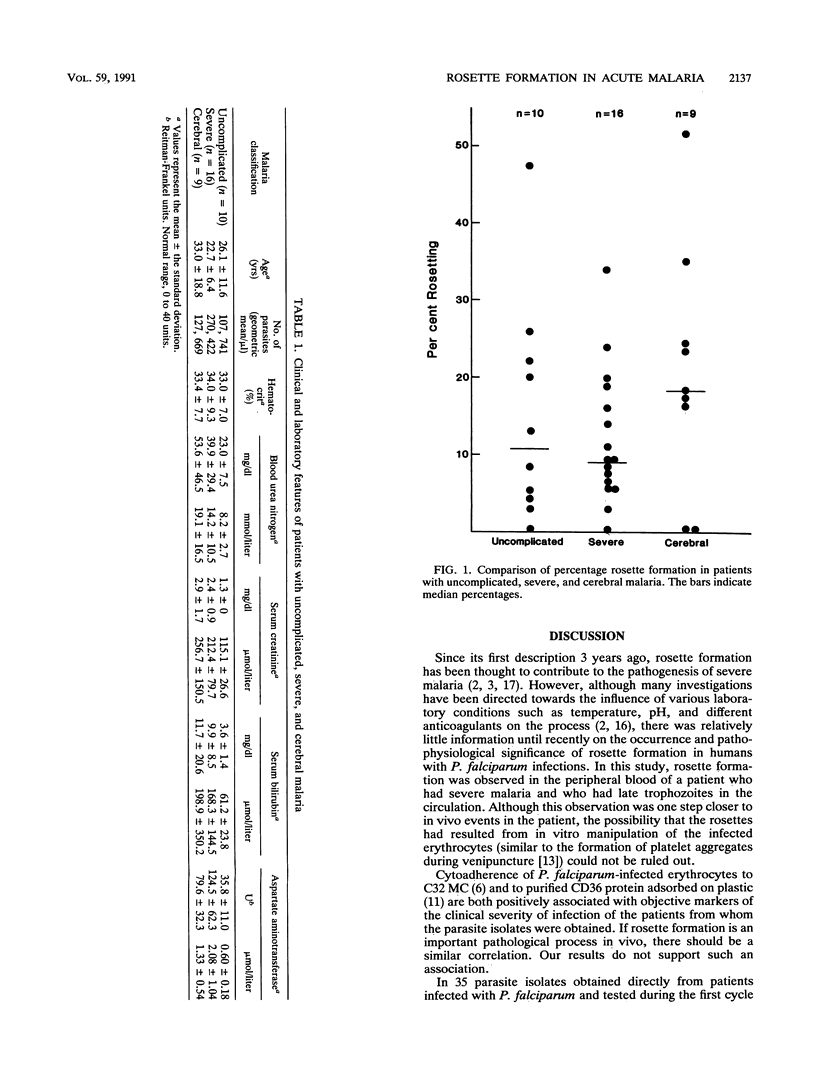
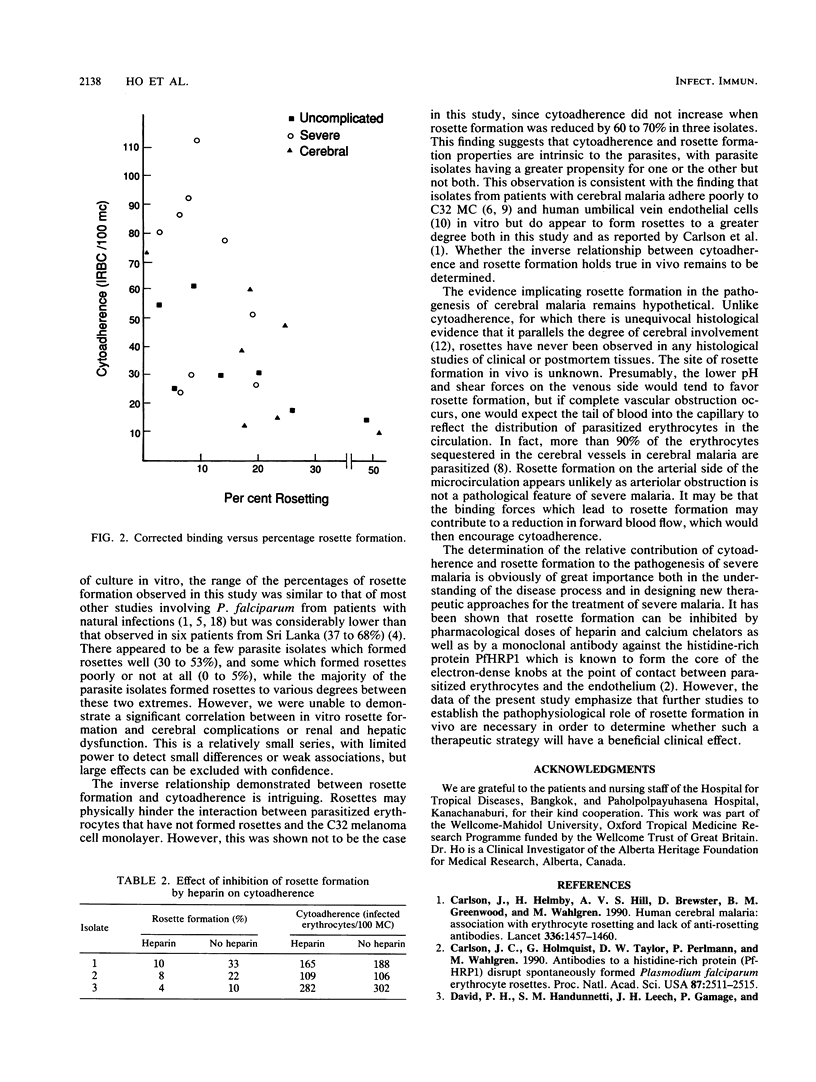
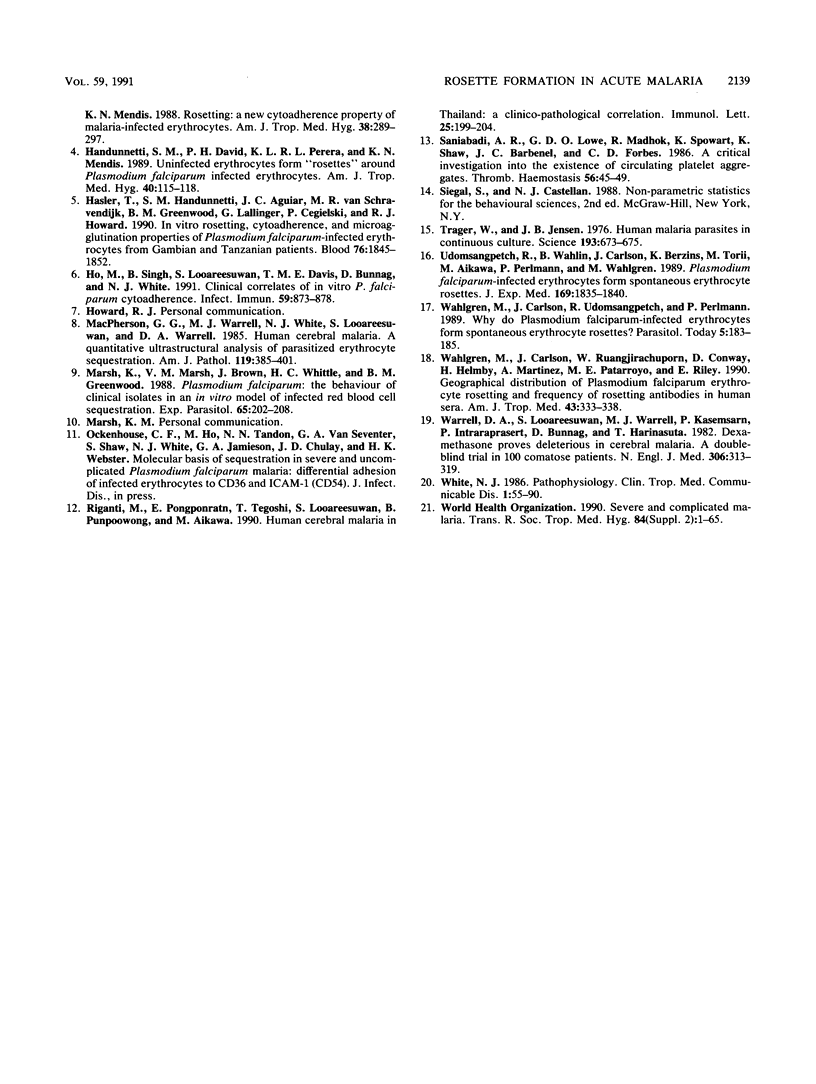
Selected References
These references are in PubMed. This may not be the complete list of references from this article.
- Carlson J., Helmby H., Hill A. V., Brewster D., Greenwood B. M., Wahlgren M. Human cerebral malaria: association with erythrocyte rosetting and lack of anti-rosetting antibodies. Lancet. 1990 Dec 15;336(8729):1457–1460. doi: 10.1016/0140-6736(90)93174-n. [DOI] [PubMed] [Google Scholar]
- Carlson J., Holmquist G., Taylor D. W., Perlmann P., Wahlgren M. Antibodies to a histidine-rich protein (PfHRP1) disrupt spontaneously formed Plasmodium falciparum erythrocyte rosettes. Proc Natl Acad Sci U S A. 1990 Apr;87(7):2511–2515. doi: 10.1073/pnas.87.7.2511. [DOI] [PMC free article] [PubMed] [Google Scholar]
- David P. H., Handunnetti S. M., Leech J. H., Gamage P., Mendis K. N. Rosetting: a new cytoadherence property of malaria-infected erythrocytes. Am J Trop Med Hyg. 1988 Mar;38(2):289–297. doi: 10.4269/ajtmh.1988.38.289. [DOI] [PubMed] [Google Scholar]
- Handunnetti S. M., David P. H., Perera K. L., Mendis K. N. Uninfected erythrocytes form "rosettes" around Plasmodium falciparum infected erythrocytes. Am J Trop Med Hyg. 1989 Feb;40(2):115–118. doi: 10.4269/ajtmh.1989.40.115. [DOI] [PubMed] [Google Scholar]
- Hasler T., Handunnetti S. M., Aguiar J. C., van Schravendijk M. R., Greenwood B. M., Lallinger G., Cegielski P., Howard R. J. In vitro rosetting, cytoadherence, and microagglutination properties of Plasmodium falciparum-infected erythrocytes from Gambian and Tanzanian patients. Blood. 1990 Nov 1;76(9):1845–1852. [PubMed] [Google Scholar]
- Ho M., Singh B., Looareesuwan S., Davis T. M., Bunnag D., White N. J. Clinical correlates of in vitro Plasmodium falciparum cytoadherence. Infect Immun. 1991 Mar;59(3):873–878. doi: 10.1128/iai.59.3.873-878.1991. [DOI] [PMC free article] [PubMed] [Google Scholar]
- MacPherson G. G., Warrell M. J., White N. J., Looareesuwan S., Warrell D. A. Human cerebral malaria. A quantitative ultrastructural analysis of parasitized erythrocyte sequestration. Am J Pathol. 1985 Jun;119(3):385–401. [PMC free article] [PubMed] [Google Scholar]
- Marsh K., Marsh V. M., Brown J., Whittle H. C., Greenwood B. M. Plasmodium falciparum: the behavior of clinical isolates in an in vitro model of infected red blood cell sequestration. Exp Parasitol. 1988 Apr;65(2):202–208. doi: 10.1016/0014-4894(88)90123-3. [DOI] [PubMed] [Google Scholar]
- Riganti M., Pongponratn E., Tegoshi T., Looareesuwan S., Punpoowong B., Aikawa M. Human cerebral malaria in Thailand: a clinico-pathological correlation. Immunol Lett. 1990 Aug;25(1-3):199–205. doi: 10.1016/0165-2478(90)90115-7. [DOI] [PubMed] [Google Scholar]
- Saniabadi A. R., Lowe G. D., Madhok R., Spowart K., Shaw B., Barbenel J. C., Forbes C. D. A critical investigation into the existence of circulating platelet aggregates. Thromb Haemost. 1986 Aug 20;56(1):45–49. [PubMed] [Google Scholar]
- Trager W., Jensen J. B. Human malaria parasites in continuous culture. Science. 1976 Aug 20;193(4254):673–675. doi: 10.1126/science.781840. [DOI] [PubMed] [Google Scholar]
- Udomsangpetch R., Wåhlin B., Carlson J., Berzins K., Torii M., Aikawa M., Perlmann P., Wahlgren M. Plasmodium falciparum-infected erythrocytes form spontaneous erythrocyte rosettes. J Exp Med. 1989 May 1;169(5):1835–1840. doi: 10.1084/jem.169.5.1835. [DOI] [PMC free article] [PubMed] [Google Scholar]
- Wahlgren M., Carlson J., Ruangjirachuporn W., Conway D., Helmby H., Martinez A., Patarroyo M. E., Riley E. Geographical distribution of Plasmodium falciparum erythrocyte rosetting and frequency of rosetting antibodies in human sera. Am J Trop Med Hyg. 1990 Oct;43(4):333–338. doi: 10.4269/ajtmh.1990.43.333. [DOI] [PubMed] [Google Scholar]
- Wahlgren M., Carlson J., Udomsangpetch R., Perlmann P. Why do Plasmodium falciparumm-infected erythrocytes form spontaneous erythrocyte rosettes? Parasitol Today. 1989 Jun;5(6):183–185. doi: 10.1016/0169-4758(89)90141-5. [DOI] [PubMed] [Google Scholar]
- Warrell D. A., Looareesuwan S., Warrell M. J., Kasemsarn P., Intaraprasert R., Bunnag D., Harinasuta T. Dexamethasone proves deleterious in cerebral malaria. A double-blind trial in 100 comatose patients. N Engl J Med. 1982 Feb 11;306(6):313–319. doi: 10.1056/NEJM198202113060601. [DOI] [PubMed] [Google Scholar]


